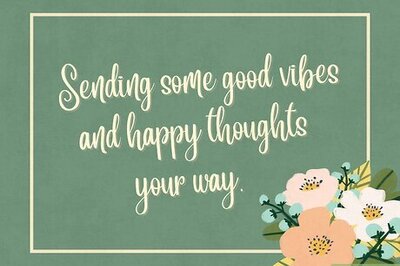
views
What is an art journal?
An art journal is a visual diary that combines writing and visual art. Unlike a traditional journal, an art journal (or visual journal) incorporates color, images, patterns, and various materials to create different mixed-media artwork on each page. You can use any materials you like, though things like paint, markers, ink, and watercolor are common. The purpose of an art journal is to express yourself and your emotions by experimenting with various art techniques and materials. Think of an art journal like a sketchbook that incorporates several art materials instead of just ink or pencil. Every person art journals a bit differently, so there are no definitive rules for what you should or should not include.
How to Start Art Journaling
Choose a journal or sketchbook with thick paper. Before starting an art journal, consider what kind of journal you want. In general, it’s best to choose a journal, sketchbook, or other medium with thick pages, as paint and ink may bleed through thin paper. Consider how large or small you want your journal to be, and if you prefer a spiral or hardbound book. If you want something on the larger side, go for an A4-sized journal. For something a bit smaller, consider an A5. Spiral-bound sketchbooks and journals can lay flat or fold over, making them a practical choice, especially if you want to take out pages. Hardbound journals, on the other hand, may not lay as flat, but they offer greater durability and protection. You don’t have to use an actual journal for your art journal. Sketchbooks and notebooks also work, or you can make your own art journal by painting over the pages of an old book. If you want to get creative, bind your own journal.
Gather your favorite art supplies and set up your workspace. You don’t have to have any specific art supplies to start your journal. However, some common materials include pens, markers, paint brushes, acrylic paint, and watercolors. Gather whatever you want to use and set up your workspace, like a desk or a table. Cover the surface with newspaper or old towels so you don’t make a mess.
Decide what type of art you want to put in your journal. There isn’t a right or wrong way to art journal, so it’s up to you what kind of art you want to do. Some people include many different types of art, like painting and collaging, in a single journal, while others prefer to keep different journals for different types of art. If you’re not sure what you want to do, go with the flow! Feel free to look up different art journaling spreads online to get a feel for what you like. Check the “art journaling” tag on social media sites like Pinterest, Instagram, or YouTube.
Make a background. To begin your first art journal spread, design your background. Many people prefer to do this by painting the journal’s pages with acrylic paint, but you can use whatever medium you like. If you prefer, use some scrapbooking paper or cut a page out of a magazine and glue it into your journal to use as the first layer of your piece. Creating a background removes some of the stress or anxiety of staring at a blank white page, and it gives you an open area to start journaling. If you don’t want to make a definitive background, that’s totally fine! It’s your journal to do as you please.
Add layers with different art supplies. Once your background is dry, give your spread more depth and color by adding layers with different art supplies. Paint on a design, stamp on a pattern, or add some stickers. Glue in some images from a magazine or some loose papers you have lying around to add texture. When deciding what you want to paint or draw, Schweiger says, “Ask [yourself] what types of techniques, tools, colors, lines, and shapes [you can] use to really express your message. [Choose] specific paint brushes, specific brush strokes, and a specific composition that really supports what it is that you’re wanting to say, what you’re wanting to express.”
Create a focal point. If your spread feels incomplete or like it’s missing something, add an image to be your focal point—the place your eyes are first drawn to. Draw or paint an image yourself, or if you prefer, cut out a large image to finish off your collage. As usual, your focal point can be anything you want. For example, if your background and layers are mainly blue, consider an ocean-themed focal point, like a dolphin. Consider following the "rule of thirds." Imagine your image is divided into 9 equal parts, like a tic-tac-toe board. The imaginary lines mark the thirds of the image, and adding an object to one of those lines will naturally attract the eye.
Write a journal entry. Once you’ve finished your spread and allowed it to dry completely, you may choose to write something. Like all elements of an art journal, this isn’t required, but it can be a nice touch, especially if you like the “journaling” aspect of art journaling. Write about your day, include your favorite quote or song lyrics, or write whatever you feel like writing. If you’re not sure what to write, try looking up some writing or journaling prompts online.
The Benefits of Art Journaling
Art journaling promotes creativity. Art journaling allows you to think outside the box and get your creative juices flowing. You’re not limited by rules or guidelines, which allows you to be as creative and artistic as you like. Art journaling is a great hobby if you’re looking for a way to be more imaginative and innovative.
It helps you relax. Art journaling can be good for your mental health, as it allows you to unwind and reduce stress. Your journal is a safe place for you to explore and talk about your emotions in both visual and written forms, and many people turn to art journaling when they’re dealing with a challenging situation in their lives.
There’s no fear of judgment. Often, people stop pursuing art because they fear they’re not as talented as other people. However, your art journal is private—unless you choose to share your work with someone, you’re the only one who will see it. This is a great way to build confidence and do what you enjoy without worrying what others think.
Your artistic skills will develop more quickly. The more you art journal, the quicker you’ll find your art style. You’ll figure out which types of art you like and don’t like, and you’ll learn new techniques at a pace that works for you. When you finish an art journal, look back at your first spread. You’ll probably notice a big difference in your style from the first page and the last.
It’s a fun hobby you can do daily. At the end of the day, art journaling is simply fun! It’s a playful activity that doesn’t force you to take yourself or your craft seriously. Unleash your inner child and make fun pieces of art each day—or as often as you choose.
Art Journaling Ideas
Incorporate old art into a new spread. Sometimes, our art doesn’t turn out the way we envisioned, and that’s okay! If you’re not happy with an existing piece, give it new life by using it in an art journal spread. Try cutting or ripping up a piece of art and glue it into your art journal as a collage. You may like the new piece more than the original!
Make swatches of your art supplies. If you’re in the mood to create but can’t figure out what to paint or write, fill a page or two with swatches of your art supplies. Test each one in a square on the page so you can see what they look like. This is great if you just bought some new supplies and aren’t sure how they’ll look in your journal. For example, if you just bought a new pack of colored pencils, scribble them on the page so you can see how bright the colors are.
Create a spread based on your travels. Some people use their art journal as a type of travel journal that documents all their adventures. If you’ve recently traveled somewhere new, draw or paint the landscape, a popular tourist attraction, or items that remind you of that place. If you have photos, travel tickets, or receipts from your visit, glue those in, as well. For example, if you visited Paris, France, you might draw the Eiffel Tower or the French flag.
Make a piece of abstract art. Creating an abstract painting or drawing is a great way to get inspired, as you can do whatever you want without trying to recreate something specific. Play around with shapes and colors, and don’t worry about getting messy. Schweiger says, “Abstract art is really about creating your own language. It’s asking yourself ‘What is it that I’m wanting to say? What is it that I feel? What is it that I’m wanting to communicate?’ It’s a lot of experimentation, a lot of exploration, and it’s really about trusting one’s own intuition about what they want to say and how they want to say it.”
Illustrate your favorite song lyrics. Think about your favorite song and how you can interpret it visually. Whether you paint, draw, or collage, create an art journal spread based on the song’s lyrics and how they make you feel. If you want, write down the lyrics that inspired you, or leave them out so the piece is up to interpretation.
Create a spread using only your favorite color. Challenge yourself to create a visually interesting piece that consists of different shades of only one color. Use whatever art supplies you like. Consider painting a landscape that is all purple or a self-portrait that is all red.
Try a writing prompt. While some people prefer to focus solely on visual art in their art journals, adding journal entries or words can often add an extra layer to your spreads and make them more visually interesting. Additionally, writing in a journal is a great way to express your feelings. Here are a few writing prompts to try out: Paint your favorite quote. Make a gratitude list—write down at least 5 things you’re grateful for this week. Create a dictionary of your feelings—choose a word that describes how you’re feeling and write down the definition. Then, paint and decorate around it. Record something meaningful about your day. Do a brain dump—write down whatever comes to mind, stream-of-consciousness style. Make a dream journal by writing down whatever you dreamed the night before. Include positive affirmations or manifestations. Write down ideas for future art journal spreads or other personal projects. Make a list—a grocery list, a bucket list, a list of your favorite things, etc.
Best Supplies for Art Journaling
Pens, pencils, and markers Pens, pencils, and markers are great art journaling supplies for beginners. You can use them for almost anything, including writing, doodling, sketching, outlining, and tracing. While you can use any pens and markers you like, try to find ones that are waterproof and don’t smudge. Recommendations: Unipin fineliners, Faber Castell pitt pens, Posca paint pens If you plan on doing a lot of drawing, Schweiger recommends a blending stump: “Instead of blending the colors with our fingers, we can use a blending stump. The best way to use it is to very gently press your blending stump onto your paper and [move it] in a very gentle circular motion. It will smooth out the pencil and blend it to be a smoother consistency.”
Different sizes of paint brushes It isn’t necessary to buy expensive paint brushes, especially when you’re first starting out, but it’s a good idea to have several shapes and sizes. Larger paint brushes are good for painting backgrounds, while smaller ones allow you to add fine details. Water brushes are also great if you plan on doing a lot of watercolor.
Acrylic paint Acrylic paint is one of the best paint options for art journaling, as it’s easy to use, dries quickly, and comes in a variety of colors. It’s also affordable, and you can even find many colors at dollar stores. Acrylic paint is a great option if you want to start working with wet media.
Watercolors Watercolor paint is great if you want to create light, airy paintings, as it is transparent and allows you to easily create different layers. Professional watercolor sets can be pretty expensive, so if you’re just starting out, it may be best to choose student-grade, which is more affordable but not as high-quality. Recommendations: Winsor & Newton watercolor paint set, Artist’s Loft watercolor set
Stamps and ink pads If you don’t want to draw or paint your own designs, using stamps is a great way to add textures and patterns to your art journal spreads. Buy some cute stamps from a craft store, or make your own by carving a design out of a rubber eraser, a sponge, or even a potato. Consider getting some different colored ink pads, as well. Recommendations: Archival Ink ink pads, Stampers Anonymous stamps
Postcards, stickers, and other ephemera Many people like to incorporate aspects of junk journaling and scrapbooking into their art journals by gluing or taping in different pieces of memorabilia. If you have any old postcards, receipts, magazine pages, stickers, or other papers, feel free to add them to your art journal. This way, you don’t have to buy a bunch of journaling supplies! Junk journaling refers to making a handmade journal using recycled and found materials, like old books, magazines, and postcards. Some other things you can put in your art journal include ticket stubs, museum maps, postage stamps, handwritten lists, event announcements, and ads. EXPERT TIP Rebecca Schweiger Rebecca Schweiger Professional Artist & Art School Founder Rebecca Schweiger is a Professional Artist, Published Author, and the Founder of The Art Studio NY, New York City's #1-rated art school and global online art studio. Celebrated by TV networks, press, and celebrities including NBC, ABC, E!, Time Out New York, The Kardashians, and Big Bang Theory's Jim Parsons, Rebecca specializes in creating abstract artwork and teaching studio art classes. Her art studios provide 100+ weekly, beginner-friendly drawing and painting art classes to people around the globe. With more than 22 years of art experience, she is the author of Release Your Creativity: Discover Your Inner Artist with 15 Simple Painting Projects, and her artwork has been exhibited in more than 50 museums and galleries around the world. Rebecca holds a BFA in Painting from Boston University's School for the Arts and has participated in acclaimed artist residencies worldwide. Rebecca Schweiger Rebecca Schweiger Professional Artist & Art School Founder Create an organized system to store your art supplies. Buy some bins and put all your paint in one bin, all your brushes in another, and so on. It’s helpful to have something on wheels so you can wheel it into a closet when you’re not using it.
Sponges and other household items If you don’t want to go out and buy a bunch of art supplies, get creative and use items you have lying around the house. Clean kitchen sponges are a great way to apply acrylic paint, while makeup sponges easily blend ink from ink pads. Experiment with other items, too, like forks, bottle caps, and even toilet paper rolls.
Best Journals for Art Journaling
Jane Davenport art journals Many art journalers swear by Jane Davenport journals because they’re easy to carry around and have thick watercolor paper. This means you can add as much watercolor, paint, or other wet media as you’d like without the pages bleeding through to the other side. Plus, these journals come with blank canvas covers you can decorate yourself. Be aware that many Jane Davenport journals and sketchbooks are on the more expensive side, so they may not be the best option if you’re just starting out and aren’t sure if you want to commit to art journaling. These journals are available on the Jane Davenport website.
Dylusions creative journals The Dylusions creative journal comes in several shapes and sizes, allowing artists to choose an option that works best for the type of art they create. They even come with a chipboard cover that you can paint as you like. These journals have study pages that can hold a lot of wetness, including various sprays and water.
Canson mixed media pads Many artists are fans of the Canson mixed media pad because it’s affordable, has a spiral binding that allows pages to be removed from the journal, and because the pages are thick and sturdy. These art pads can hold various wet media, like acrylic paint, watercolor, and other mixed media, making them perfect for art journaling.
Moleskine Cahier journals If you mainly draw or do collage work and don’t need thick paper, the Moleskine Cahier may be a good option for you. These notebooks are very popular within the journaling community and come in a variety of sizes to meet your needs. However, the paper is quite thin and doesn’t hold up well with water or wet media.
Art Journaling FAQs
What are the rules of art journaling? The best thing about art journaling is that there are no rules! You can do whatever you want. Try out a bunch of different art supplies, like acrylic paint, watercolors, markers, and stamps. Sketch single images or make a colorful collage. Do what you enjoy, and don’t worry about the rest.
Can you art journal without a journal? Yes, you can art journal without using an actual journal. Art journaling is different for each individual and is mainly a way to get your creative juices flowing, so use any medium you’d like. Try watercolor paper, a composition notebook, an old book, or even a piece of cardboard.
How many art journals should you use? Use as many art journals as you’d like! Many people prefer using one journal at a time, while others prefer to use different journals for different projects. For example, you may want to dedicate one art journal to painting and another to collaging. It’s entirely up to you!
Can you have too many art journals? No! Have as many art journals as you want. If you feel like you have too many and start feeling overwhelmed, it’s okay to put them aside for now and focus on one specific journal. Art journaling is supposed to be fun, so do what works best for you.
Do you have to finish every art journal? It’s entirely okay to leave an art journal unfinished. Art journaling is meant to be a fun way to destress, so don’t worry about what you think you’re “supposed” to do. Remember, there are no rules! If you’re not vibing with one journal, it’s okay to leave it unfinished and try another one. You can always come back to it later, if you want.














Comments
0 comment